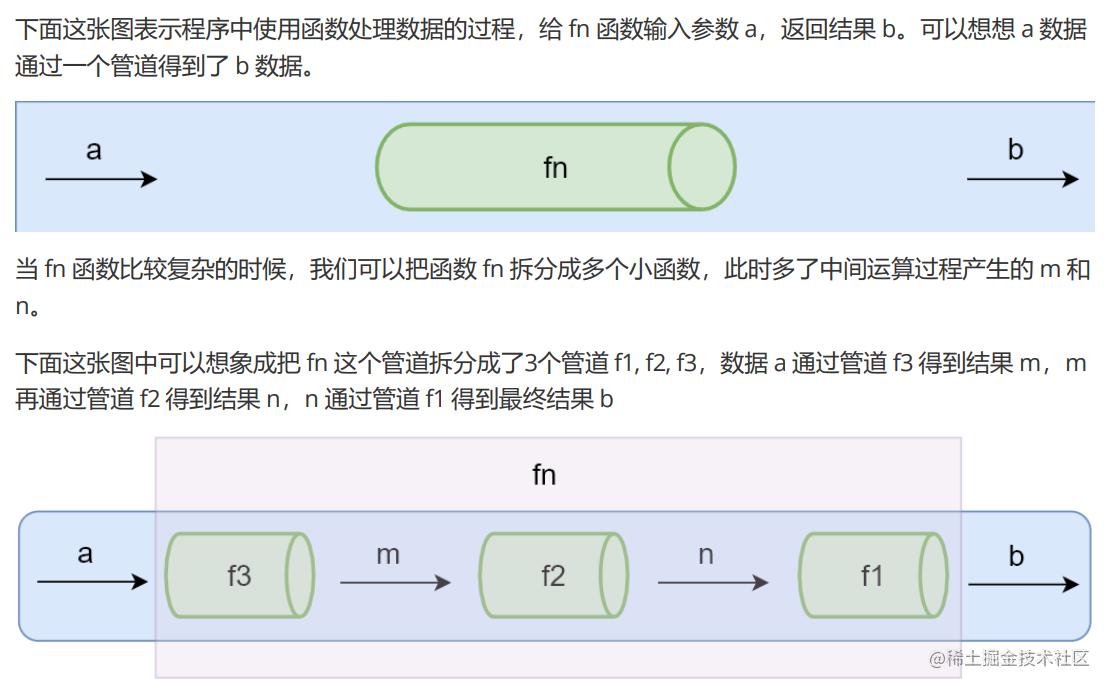函数组合
背景问题
纯函数和柯里化很容易写出洋葱代码 h(g(f(x))) 
举个例子
场景:获取数组的最后一个元素再转换成大写字母
js
_.toUpper(_.first(_.reverse(array)));
_.toUpper(_.first(_.reverse(array)));
是否有一种方案可以解决这种嵌套代码?? 函数组合可以让我们把细粒度的函数重新组合生成一个新的函数
管道
首先了解一下概念  那依据管道的思想是否可以将上面的嵌套代码改造为:
那依据管道的思想是否可以将上面的嵌套代码改造为:
js
// 伪代码
const fn = compose(reverse, first, toUpper);
const b = fn("abc");
// 伪代码
const fn = compose(reverse, first, toUpper);
const b = fn("abc");
函数组合
如果一个函数要经过多个函数处理才能得到最终值,这个时候可以把中间过程的函数合并成一个函数,这就是函数的组合。
函数组合默认是从右到左执行。如下:
js
function compose(f, g) {
return function (value) {
return f(g(value));
};
}
const reverse = (arr) => arr.reverse();
const first = (arr) => arr[0];
const last = compose(first, reverse);
console.log(f(["one", "two", "three"])); // three
function compose(f, g) {
return function (value) {
return f(g(value));
};
}
const reverse = (arr) => arr.reverse();
const first = (arr) => arr[0];
const last = compose(first, reverse);
console.log(f(["one", "two", "three"])); // three
现在的 compose 函数有什么问题?如果我们传入的参数无限增加怎么办?
因此我们需要对 compose 函数改造,让它支持不定量的函数参数。
js
const compose =
(...args) =>
(value) =>
// args 是传入的函数集合
args.reduce((acc, fn) => {
// acc 为传入每个函数的参数
return fn(acc);
}, value);
const reverse = (arr) => arr.reverse();
const first = (arr) => arr[0];
const toUpper = (s) => s.toUpperCase();
const f = compose(reverse, first, toUpper); // 从左到右运行
console.log(f(["one", "two", "three"])); // THREE
const compose =
(...args) =>
(value) =>
// args 是传入的函数集合
args.reduce((acc, fn) => {
// acc 为传入每个函数的参数
return fn(acc);
}, value);
const reverse = (arr) => arr.reverse();
const first = (arr) => arr[0];
const toUpper = (s) => s.toUpperCase();
const f = compose(reverse, first, toUpper); // 从左到右运行
console.log(f(["one", "two", "three"])); // THREE
如果我们需要改变函数组合的顺序,可以使用结合律。
js
const f = compose(reverse, compose(first, toUpper)); // 从左到右运行
console.log(f(["one", "two", "three"])); // THREE
const f = compose(reverse, compose(first, toUpper)); // 从左到右运行
console.log(f(["one", "two", "three"])); // THREE
flow() 与 flowRight()
- lodash 中组合函数 flow() 或者 flowRight(),他们都可以组合多个函数
- flow() 是从左到右运行
- flowRight() 是从右到左运行(更常使用)
函数组合-调试
我们可以使用函数组合了,但是如果其中某个函数报错了,该如何调试呢?
思路:我们可以在函数组合中,添加调试函数,打印日志信息。
贴代码:
js
const _ = require("lodash");
const trace = _.curry((tag, v) => {
console.log(tag, v);
return v;
});
const split = _.curry((sep, str) => _.split(str, sep));
const join = _.curry((sep, array) => _.join(array, sep));
const map = _.curry((fn, array) => _.map(array, fn));
const f = _.flowRight(
join("-"),
trace("map 之后"),
map(_.toLower),
trace("split 之后"),
split(" ")
);
console.log(f("NEVER SAY DIE"));
const _ = require("lodash");
const trace = _.curry((tag, v) => {
console.log(tag, v);
return v;
});
const split = _.curry((sep, str) => _.split(str, sep));
const join = _.curry((sep, array) => _.join(array, sep));
const map = _.curry((fn, array) => _.map(array, fn));
const f = _.flowRight(
join("-"),
trace("map 之后"),
map(_.toLower),
trace("split 之后"),
split(" ")
);
console.log(f("NEVER SAY DIE"));
上面的使用和我们常规的组合函数定义有什么区别呢?
lodash 中定义的*.split、*.join、 _.map 虽然是平常经常使用的方法,但并不适合在函数组合中使用,如果非要使用需要进行柯里化处理。因为函数组合中需要的是一元函数
 Attraction11
Attraction11